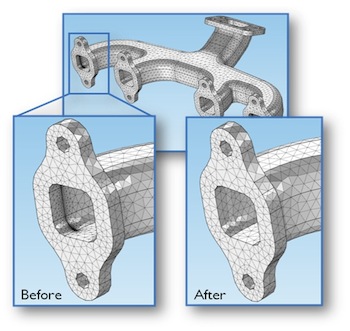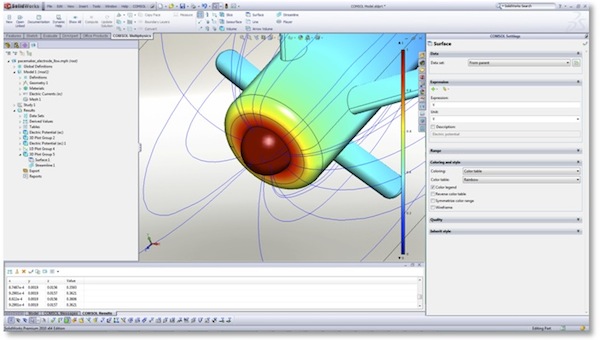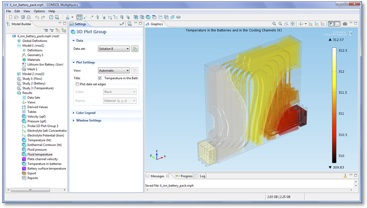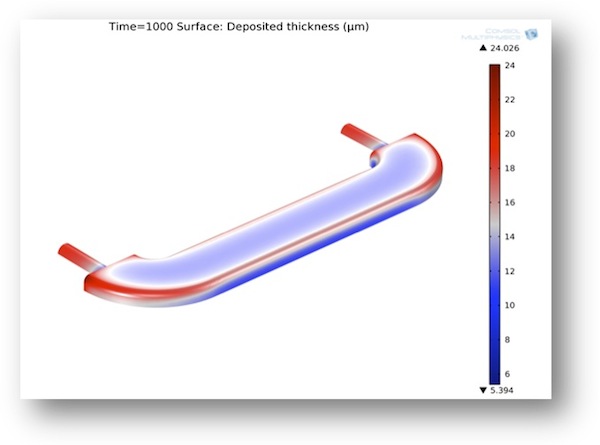Latest News
May 20, 2011
By DE Editors
 Version 4.2 includes new Virtual Geometry tools that allow for modification of CAD models without changing the underlying surface curvature. The overall effect is a mesh that accurately represents the geometry while keeping mesh size to a minimum (bottom right). |
COMSOL, Inc. has announced the release of the latest version of COMSOL Multiphysics, its simulation environment. Version 4.2, which expands the scope of applications covered by COMSOL, is now available and will be shipped to all customers with current subscriptions.
Version 4.2 expands the applications covered by COMSOL with three new application modules—Microfluidics, Geomechanics, and Electrodeposition—and new LiveLink interfaces for AutoCAD and SpaceClaim.
The company says the new release improves and expands multiphysics simulation performance for all users. New capabilities target geometry, mesh, and solver functionality.
Version 4.2 includes new virtual geometry tools for creating a mesh that identifies the essential parts of the original CAD model to enable faster and more memory efficient solving. Time-dependent adaptive meshing and automatic remeshing link solvers and meshing algorithms for any moving mesh analysis. Models with moving diffusion fronts are solved more efficiently as are simulations involving removal and deposition of materials, says COMSOL.
The new Parametric Surfaces feature allows for creation of surfaces based on analytical expressions or look-up table data.
The COMSOL direct solvers have been multicore and cluster-enabled for several years. With Version 4.2, the multiphysics assembly algorithms and iterative solvers have now also been parallelized.
“The parallelized assembly means that a lot of users get a lot of speed,” says Bjorn Sjodin, vice president of Product Management with COMSOL. “Benchmark tests indicate a speed-up of 425% for a laminar flow static mixer and 164% increase for a microfluidic lab-on-a-chip simulation.”
Version 4.2includes a new Report Generator for publishing results data. It lets users create HTML reports of varying degrees of detail. Several reports can be added to a single model, enabling users to communicate their data.
 The One Window interface in the LiveLink for SolidWorks tool lets users run COMSOL simulations directly on their CAD model from within the SolidWorks design environment. |
Drag-and-drop is now supported in the Model Builder tree to quickly edit the contents of a model. The presentation of simulation results is also updated. In the Model Builder, default plots are customized to adapt to the physics in the model with descriptive names. New plot types include histogram plots for statistical analysis, Nyquist plots for frequency response studies, and ribbon plots for flows.
 This picture shows the temperature field in the cooling channels and the Li-ion batteries of a battery pack for automotive applications. The model includes a high-fidelity electrochemical model of the batteries coupled to a thermal analysis of the batteries and the components in the battery pack as well as a fluid flow simulation in the cooling channels. |
The LiveLink for SolidWorks interface has been extended with a One Window Interface where a SolidWorks user can stay inside of the SolidWorks environment and work synchronously with COMSOL Multiphysics.
The new LiveLink for SpaceClaim interface fuses direct modeling and multiphysics simulation. Similarly, with the new LiveLink for AutoCAD users can transfer a 3D geometry from AutoCAD to COMSOL Multiphysics. For both products, the synchronized geometry in the COMSOL model stays associative with the CAD geometry in its native format.
Microfluidics Module
The new Microfluidics Module brings tools for the study of microfluidic devices and rarefied gas flows. Important applications include simulations of lab-on-a-chip devices, digital microfluidics, electrokinetic and magnetokinetic devices, inkjets, and vacuum systems.
In addition to enhanced interfaces for single-phase flow, Microfluidics Module users have dedicated interfaces for two-phase flow using the level set, phase field, and moving mesh methods. Each of these interfaces includes surface tension forces, capillary forces, and Marangoni effects.
A new free molecular flow interface using the angular coefficient method allows for simulations where the molecular mean free path is much longer than the geometric dimensions.
Geomechanics Module
The new Geomechanics Module is a specialized add-on to the Structural Mechanics Module that enables simulations of geotechnical applications such as tunnels, excavations, slope stability, and retaining structures. The module features tailored interfaces to study plasticity, deformation, and failure of soils and rocks, as well as their interaction with concrete and human-made structures.
A variety of material models for soils are provided: Cam-clay, Drucker-Prager, Mohr-Coulomb, Matsuoka-Naka, and Lade-Duncan. In addition to the built-in plasticity models, user-defined yield functions can be created using the equation-based user interface provided by the COMSOL Multiphysics environment. Dependencies of a computed temperature field as well as other field quantities can be blended into these material definitions.
The Geomechanics Module can also be used for modeling concrete and rock materials. The Willam-Warnke, Bresler-Pister, Ottosen, and Hoek-Brown models, which are available as built-in options, can be adapted and extended by users to a more general class of brittle materials. Additionally, the Geomechanics Module can be combined with analyses from other COMSOL modules such as the porous media flow, poroelasticity, and solute transport functionality of the Subsurface Flow Module.
Electrodepsition Module
The Electrodeposition Module simulates electrodeposition processes. Physics interfaces are provided for primary, secondary, and tertiary current distribution models, while geometric representations of deposited layer buildup are included as model parameters.
 This model showing the thickness of a decorative deposited layer in a furniture fitting was created using the new COMSOL Electrodeposition Module. |
COMSOL says the Electrodeposition Module is applicable to a variety of applications including; metal deposition for electronics and electrical parts, corrosion and wear protection, decorative electroplating, electroforming of parts with thin and complex structures, and metal electrowinning.
For more information, visit COMSOL.
Sources: Press materials received from the company and additional information gleaned from the company’s website.
Subscribe to our FREE magazine, FREE email newsletters or both!
Latest News
About the Author
DE’s editors contribute news and new product announcements to Digital Engineering.
Press releases may be sent to them via [email protected].






